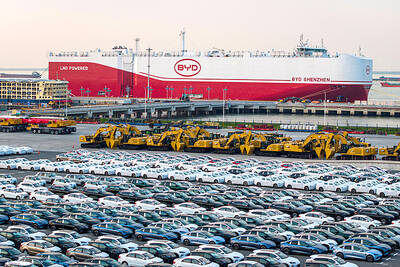The central bank yesterday introduced a series of regulatory measures that respond to the predicted effects of climate change on the nation’s economy and financial system, as Taiwan seeks to achieve net zero carbon emissions by 2050.
The top monetary policymaker said it has mapped out a framework for advancing two main policy goals — bolstering Taiwan’s economic and financial resilience with regard to climate change risks, and supporting a smooth transition to a sustainable green economy.
The central bank said it is cooperating with the Financial Supervisory Commission to help create a favorable environment for green and sustainable investment, bolster its understanding of climate risks, and factor those risks into daily operations and foreign exchange reserve management.

Photo: Liao Chen-hui, Taipei Times
Specifically, the bank said it would factor in climate change risks when projecting national GDP growth and establish models for each economic sector to gain a better understanding of the risks involved.
Further, the central bank plans to include sustainable financial performance into its open market operations, and use the measure on small-amount repurchase operations as a reference when processing deposit renewals and transfers.
The central bank said it would also conduct research on climate change risks as part of a macro-prudential tool, and invite experts and academics to conduct a stress test of financial institutions based on climate change risks.
Additionally, the bank said it would consider purchasing green bonds when managing foreign exchange reserves, and promote participation in international discussions and activities regarding climate change issues.
The bank has taken part in discussions and online meetings with Southeast Asian central banks and the Network of Central Banks and Supervisors for Greening the Financial System, it said.

Micron Memory Taiwan Co (台灣美光), a subsidiary of US memorychip maker Micron Technology Inc, has been granted a NT$4.7 billion (US$149.5 million) subsidy under the Ministry of Economic Affairs A+ Corporate Innovation and R&D Enhancement program, the ministry said yesterday. The US memorychip maker’s program aims to back the development of high-performance and high-bandwidth memory chips with a total budget of NT$11.75 billion, the ministry said. Aside from the government funding, Micron is to inject the remaining investment of NT$7.06 billion as the company applied to participate the government’s Global Innovation Partnership Program to deepen technology cooperation, a ministry official told the

Taiwan Semiconductor Manufacturing Co (TSMC, 台積電), the world’s leading advanced chipmaker, officially began volume production of its 2-nanometer chips in the fourth quarter of this year, according to a recent update on the company’s Web site. The low-key announcement confirms that TSMC, the go-to chipmaker for artificial intelligence (AI) hardware providers Nvidia Corp and iPhone maker Apple Inc, met its original roadmap for the next-generation technology. Production is currently centered at Fab 22 in Kaohsiung, utilizing the company’s first-generation nanosheet transistor technology. The new architecture achieves “full-node strides in performance and power consumption,” TSMC said. The company described the 2nm process as

Shares in Taiwan closed at a new high yesterday, the first trading day of the new year, as contract chipmaker Taiwan Semiconductor Manufacturing Co (TSMC, 台積電) continued to break records amid an artificial intelligence (AI) boom, dealers said. The TAIEX closed up 386.21 points, or 1.33 percent, at 29,349.81, with turnover totaling NT$648.844 billion (US$20.65 billion). “Judging from a stronger Taiwan dollar against the US dollar, I think foreign institutional investors returned from the holidays and brought funds into the local market,” Concord Securities Co (康和證券) analyst Kerry Huang (黃志祺) said. “Foreign investors just rebuilt their positions with TSMC as their top target,

POTENTIAL demand: Tesla’s chance of reclaiming its leadership in EVs seems uncertain, but breakthrough in full self-driving could help boost sales, an analyst said Chinese auto giant BYD Co (比亞迪) is poised to surpass Tesla Inc as the world’s biggest electric vehicle (EV) company in annual sales. The two groups are expected to soon publish their final figures for this year, and based on sales data so far this year, there is almost no chance the US company led by CEO Elon Musk would retain its leadership position. As of the end of last month, BYD, which also produces hybrid vehicles, had sold 2.07 million EVs. Tesla, for its part, had sold 1.22 million by the end of September. Tesla’s September figures included a one-time boost in